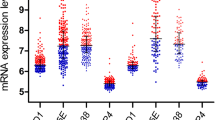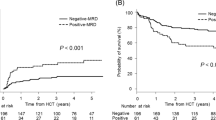Abstract
The E2A-PBX1 rearrangement is common in B cell acute lymphoblastic leukemia (B-ALL). However, whether this fusion gene can be used as a reliable marker for minimal residual disease (MRD) following allogeneic hematopoietic stem cell transplantation (allo-HSCT) remains unknown. In this study, clinical data were collected from 28 consecutive B-ALL patients who received allo-HSCT. Their MRD was evaluated by E2A-PBX1 and leukemia-associated immunophenotype (LAIP). The median follow-up was 374 days (55–2342 days). Of the enrolled patients, seven (25%) patients died of leukemia relapse. A total of nine (32.1%) patients experienced relapse at a median of 164 days (75–559 days) after transplantation. The median expression level in the first positive sample was 0.14% (0.0071–902.4%). The duration from E2A-PBX1-positive results to hematological relapse was 74 days (30–469 days). E2A-PBX1 expression generally became positive prior to flow cytometry. Patients with positive E2A-PBX1 gene expression pre-transplantation were more likely to have positive E2A-PBX1 expression after transplantation. Taken all together, E2A-PBX1 expression determined by real-time quantitative reverse transcriptase polymerase chain reaction (RQ-PCR) could be used to evaluate MRD status after allo-HSCT. Patients with positive E2A-PBX1 expression after transplant will have a poor prognosis.



Similar content being viewed by others
References
Mo XD, Lv M, Huang XJ (2017) Preventing relapse after haematopoietic stem cell transplantation for acute leukaemia: the role of post-transplantation minimal residual disease (MRD) monitoring and MRD-directed intervention. Br J Haematol 179:184–197. https://doi.org/10.1111/bjh.14778
Eckert C, von Stackelberg A, Seeger K, Groeneveld TW, Peters C, Klingebiel T, Borkhardt A, Schrappe M, Escherich G, Henze G (2013) Minimal residual disease after induction is the strongest predictor of prognosis in intermediate risk relapsed acute lymphoblastic leukaemia—long-term results of trial ALL-REZ BFM P95/96. Eur J Cancer 49(6):1346–1355. https://doi.org/10.1016/j.ejca.2012.11.010
Salek C, Folber F, Fronkova E, Prochazka B, Marinov I, Cetkovsky P, Mayer J, Doubek M, Czech Leukemia Study Group - for L (2016) Early MRD response as a prognostic factor in adult patients with acute lymphoblastic leukemia. Eur J Haematol 96(3):276–284. https://doi.org/10.1111/ejh.12587
Zhu HH, Zhang XH, Qin YZ, Liu DH, Jiang H, Chen H, Jiang Q, Xu LP, Lu J, Han W, Bao L, Wang Y, Chen YH, Wang JZ, Wang FR, Lai YY, Chai JY, Wang LR, Liu YR, Liu KY, Jiang B, Huang XJ (2013) MRD-directed risk stratification treatment may improve outcomes of t(8;21) AML in the first complete remission: results from the AML05 multicenter trial. Blood 121(20):4056–4062. https://doi.org/10.1182/blood-2012-11-468348
Liu J, Wang Y, Xu LP, Liu DH, Qin YZ, Chang YJ, Liu KY, Huang XJ (2014) Monitoring mixed lineage leukemia expression may help identify patients with mixed lineage leukemia—rearranged acute leukemia who are at high risk of relapse after allogeneic hematopoietic stem cell transplantation. Biol Blood Marrow Transplant 20(7):929–936. https://doi.org/10.1016/j.bbmt.2014.03.008
Zhao X, Hong Y, Qin Y, Xu Y, Chang Y, Wang Y, Zhang X, Xu L, Huang X (2017) The clinical significance of monitoring the expression of the SIL-TAL1 fusion gene in T-cell acute lymphoblastic leukemia after allogeneic hematopoietic stem cell transplantation. Int J Lab Hematol 39:613–619. https://doi.org/10.1111/ijlh.12711
Ribera JM, Ortega JJ, Oriol A, Granada I, Hernandez-Rivas JM, Parody R, Bethencourt C, Rivas C, Bastida P, del Potro E, Gonzalez-Valentin ME, Moreno MJ, Besalduch J, Fernandez-Calvo J, Tormo M, Arias J, Molines A, Sanz MA, Maldonado J, Milla F, Feliu E, San Miguel JF (2002) Prognostic value of karyotypic analysis in children and adults with high-risk acute lymphoblastic leukemia included in the PETHEMA ALL-93 trial. Haematologica 87(2):154–166
Hunger SP (1996) Chromosomal translocations involving the E2A gene in acute lymphoblastic leukemia: clinical features and molecular pathogenesis. Blood 87(4):1211–1224
Vey N, Thomas X, Picard C, Kovascovicz T, Charin C, Cayuela JM, Dombret H, Dastugue N, Huguet F, Bastard C, Stamatoulas A, Giollant M, Tournilhac O, Macintyre E, Buzyn A, Bories D, Kuentz M, Dreyfus F, Delannoy A, Raynaud S, Gratecos N, Bordessoule D, de Botton S, Preudhomme C, Reman O, Troussard X, Pigneux A, Bilhou C, Vernant JP, Boucheix C, Gabert J, Research G-LGtSGfCC (2006) Allogeneic stem cell transplantation improves the outcome of adults with t(1;19)/E2A-PBX1 and t(4;11)/MLL-AF4 positive B-cell acute lymphoblastic leukemia: results of the prospective multicenter LALA-94 study. Leukemia 20(12):2155–2161. https://doi.org/10.1038/sj.leu.2404420
Zhao W, Li ZG, Gao C (2008) Detection of E2A/PBX1 fusion gene and its clinical significance in childhood acute lymphoblastic leukemia. Zhonghua er ke za zhi = Chin J Pediatr 46(7):550–551
Zhao X, Qin Y, Zhang Y, Xu Y, Wang Y, Chen H, Wang F, Wang J, Huang X (2015) Clinical significance of monitoring E2A- PBX1 fusion gene expression in patients with allogeneic hematopoietic stem cell transplantation. Zhonghua xue ye xue za zhi = Zhonghua xueyexue zazhi 36(12):989–993. https://doi.org/10.3760/cma.j.issn.0253-2727.2015.12.002
Huang XJ, Liu DH, Liu KY, Xu LP, Chen H, Han W, Chen YH, Wang JZ, Gao ZY, Zhang YC, Jiang Q, Shi HX, Lu DP (2006) Haploidentical hematopoietic stem cell transplantation without in vitro T-cell depletion for the treatment of hematological malignancies. Bone Marrow Transplant 38(4):291–297. https://doi.org/10.1038/sj.bmt.1705445
Wang Y, Liu QF, Xu LP, Liu KY, Zhang XH, Ma X, Fan ZP, Wu DP, Huang XJ (2015) Haploidentical vs identical-sibling transplant for AML in remission: a multicenter, prospective study. Blood 125(25):3956–3962. https://doi.org/10.1182/blood-2015-02-627786
Gabert J, Beillard E, van der Velden VH, Bi W, Grimwade D, Pallisgaard N, Barbany G, Cazzaniga G, Cayuela JM, Cave H, Pane F, Aerts JL, De Micheli D, Thirion X, Pradel V, Gonzalez M, Viehmann S, Malec M, Saglio G, van Dongen JJ (2003) Standardization and quality control studies of ‘real-time’ quantitative reverse transcriptase polymerase chain reaction of fusion gene transcripts for residual disease detection in leukemia—a Europe Against Cancer program. Leukemia 17(12):2318–2357. https://doi.org/10.1038/sj.leu.2403135
Zhao XS, Jin S, Zhu HH, Xu LP, Liu DH, Chen H, Liu KY, Huang XJ (2012) Wilms’ tumor gene 1 expression: an independent acute leukemia prognostic indicator following allogeneic hematopoietic SCT. Bone Marrow Transplant 47(4):499–507. https://doi.org/10.1038/bmt.2011.121
Mo XD, Zhang XH, Xu LP, Wang Y, Yan CH, Chen H, Chen YH, Han W, Wang FR, Wang JZ, Liu KY, Huang XJ (2017) Comparison of outcomes after donor lymphocyte infusion with or without prior chemotherapy for minimal residual disease in acute leukemia/myelodysplastic syndrome after allogeneic hematopoietic stem cell transplantation. Ann Hematol 96(5):829–838. https://doi.org/10.1007/s00277-017-2960-7
Yan CH, Wang JZ, Liu DH, Xu LP, Chen H, Liu KY, Huang XJ (2013) Chemotherapy followed by modified donor lymphocyte infusion as a treatment for relapsed acute leukemia after haploidentical hematopoietic stem cell transplantation without in vitro T-cell depletion: superior outcomes compared with chemotherapy alone and an analysis of prognostic factors. Eur J Haematol 91(4):304–314. https://doi.org/10.1111/ejh.12168
Christopher JC, Knechtli NJG, Hancock JP (1998) Minimal residual disease status before allogeneic bone marrow transplantation is an important determinant of successful outcome for children and adolescents with acute lymphoblastic leukemia. Blood 92(11):4072–4079
Ma L, Hao S, Diong C, Goh YT, Gopalakrishnan S, Ho A, Hwang W, Koh LP, Koh M, Lim ZY, Loh Y, Poon M, Tan LK, Tan P, Linn YC (2015) Pre-transplant achievement of negativity in minimal residual disease and French-American-British L1 morphology predict superior outcome after allogeneic transplant for Philadelphia chromosome positive acute lymphoblastic leukemia: an analysis of Southeast Asian patients. Leuk Lymphoma 56(5):1362–1369. https://doi.org/10.3109/10428194.2014.956318
van der Velden VH (2001) Real-time quantitative PCR for detection of minimal residual disease before allogeneic stem cell transplantation predicts outcome in children with acute lymphoblastic leukemia. Leukemia 15:1485–1487
Ommen HB, Touzart A, MacIntyre E, Kern W, Haferlach T, Haferlach C, Tobal K, Hokland P, Schnittger S (2015) The kinetics of relapse in DEK-NUP214-positive acute myeloid leukemia patients. Eur J Haematol 95(5):436–441. https://doi.org/10.1111/ejh.12511
Zhao XS, Liu YR, Zhu HH, Xu LP, Liu DH, Liu KY, Huang XJ (2012) Monitoring MRD with flow cytometry: an effective method to predict relapse for ALL patients after allogeneic hematopoietic stem cell transplantation. Ann Hematol 91(2):183–192. https://doi.org/10.1007/s00277-011-1285-1
Shahkarami S, Mehrasa R, Younesian S, Yaghmaie M, Chahardouli B, Vaezi M, Rezaei N, Nikbakht M, Alimoghaddam K, Ghavamzadeh A, Tavakkoly-Bazzaz J, Ghaffari SH (2018) Minimal residual disease (MRD) detection using rearrangement of immunoglobulin/T cell receptor genes in adult patients with acute lymphoblastic leukemia (ALL). Ann Hematol 97(4):585–595. https://doi.org/10.1007/s00277-018-3230-z
Clark JR, Scott SD, Jack AL, Lee H, Mason J, Carter GI, Pearce L, Jackson T, Clouston H, Sproul A, Keen L, Molloy K, Folarin N, Whitby L, Snowden JA, Reilly JT, Barnett D (2015) Monitoring of chimerism following allogeneic haematopoietic stem cell transplantation (HSCT): technical recommendations for the use of short tandem repeat (STR) based techniques, on behalf of the United Kingdom National External Quality Assessment Service for Leucocyte Immunophenotyping Chimerism Working Group. Br J Haematol 168(1):26–37. https://doi.org/10.1111/bjh.13073
Zhao XS, Yan CH, Liu DH, Xu LP, Liu YR, Liu KY, Qin YZ, Wang Y, Huang XJ (2013) Combined use of WT1 and flow cytometry monitoring can promote sensitivity of predicting relapse after allogeneic HSCT without affecting specificity. Ann Hematol 92(8):1111–1119. https://doi.org/10.1007/s00277-013-1733-1
Eldfors S, Kuusanmaki H, Kontro M, Majumder MM, Parsons A, Edgren H, Pemovska T, Kallioniemi O, Wennerberg K, Gokbuget N, Burmeister T, Porkka K, Heckman CA (2017) Idelalisib sensitivity and mechanisms of disease progression in relapsed TCF3-PBX1 acute lymphoblastic leukemia. Leukemia 31(1):51–57. https://doi.org/10.1038/leu.2016.202
Funding
This work was supported by the National Natural Science Foundation of China (81670175), the Key Program of National Natural Science Foundation of China (81230013), the Foundation for Innovative Research Groups of the National Natural Science Foundation of China (81621001), the Scientific Research Foundation for Capital Medicine Development (2016-1-4082), and the Beijing Key Laboratory for Hematopoietic Stem Cell Transplantation.
Author information
Authors and Affiliations
Corresponding author
Ethics declarations
Conflict of interest
The authors declare that they have no competing interests.
Rights and permissions
About this article
Cite this article
Hong, Y., Zhao, X., Qin, Y. et al. The prognostic role of E2A-PBX1 expression detected by real-time quantitative reverse transcriptase polymerase chain reaction (RQ-PCR) in B cell acute lymphoblastic leukemia after allogeneic hematopoietic stem cell transplantation. Ann Hematol 97, 1547–1554 (2018). https://doi.org/10.1007/s00277-018-3338-1
Received:
Accepted:
Published:
Issue Date:
DOI: https://doi.org/10.1007/s00277-018-3338-1




